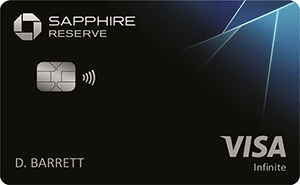How to Earn a Travel Credit Card’s Sign-Up Bonus
Most cards require you to meet a minimum spend within a set amount of time to earn the sign-up bonus.

Many or all of the products on this page are from partners who compensate us when you click to or take an action on their website, but this does not influence our evaluations or ratings. Our opinions are our own.
These sign-up bonuses reward you with points or miles for meeting spending requirements in a set timeframe.
To maximize your rewards, consider factors like spending habits and travel goals when choosing a card.
Don't miss out — make sure you meet the minimum spending requirement within the timeframe to qualify.
These sign-up bonuses reward you with points or miles for meeting spending requirements in a set timeframe.
To maximize your rewards, consider factors like spending habits and travel goals when choosing a card.
Don't miss out — make sure you meet the minimum spending requirement within the timeframe to qualify.
Have you signed up for a new travel credit card recently? Then, you're probably eligible to earn a huge chunk of points within the first few months of holding the card. Many banks offer sign-up bonuses for new credit cards to entice you to apply.
These welcome offers can be incredibly lucrative, though you’ll need to meet criteria in order to receive them. Here's a look at what sign-up bonuses are, the different types you’ll find and how to earn the sign-up bonus on your next travel credit card.
What are credit card sign-up bonuses?
Because of fierce competition in the credit card market, banks need a way to stand out. They can do this in a variety of methods, but a common one is via a credit card sign-up bonus. These bonuses will usually deposit a lump-sum number of rewards into your account once you’ve spent a certain amount of money.
You’ll see these offers when signing up for a credit card. For example, a card could offer the ability to earn 60,000 bonus points after spending $4,000 in the first three months that you own the card.
» Learn more: The best travel credit cards right now
Is there more than one type of sign-up bonus?
Yes. The type of bonus you receive will depend on a few different factors, including the credit card. If you’ve signed up for an airline credit card, your sign-up bonus may be in the form of airline miles. The same goes for hotel credit cards.
Some card issuers, like American Express, have their own type of currency, which can be used in a variety of ways including booking through their travel portal, transferring to hotel and airline partners, redeeming for gift cards, donating points and more. You can also find sign-up bonuses in the form of cash deposits or statement credits.
By and large, however, the most common type of sign-up bonus you’ll encounter will be the one that requires that you spend a certain amount of money within a certain amount of time.
» Learn more: The best travel credit card welcome bonuses right now
How to keep from missing it
There’s no disappointment quite like realizing you’ve missed out on your credit card’s sign-up bonus. When seeking to avoid this mistake, there are two things you’ll need to remember:
How much money you’ve already spent.
How many days you have left to earn the bonus.
Figuring out how much you’ve spent
Thanks to online banking, it’s easier than ever to keep tabs on the amount of money you’re putting on your card each month. However, when seeking to earn a credit card’s sign-up bonus, you’ll need to keep detailed track of your credit card’s balance. Why? Because not everything on your card will qualify as spending toward your sign-up bonus.
Try to time your credit card sign-ups with large purchases you’re already planning to make.
Annual fees, late fees and interest charges are all good examples of this. Let’s say that you’ve signed up for the Chase Sapphire Reserve® – Earn 60,000 bonus points after you spend $5,000 on purchases in the first 3 months from account opening.
You peeked at your card balance and you're just a few hundred dollars over the amount needed to qualify for the welcome offer. Eagerly, you await those sign-up bonus point to come rolling in, but they never do. What gives?
After a phone call with a Chase representative, you realize that you hadn’t accounted for the $550 annual fee that comes with the Chase Sapphire Reserve®. This fee doesn’t count toward your sign-up bonus and now you’ve lost it.
Don’t make this mistake. Your credit card statement will give you a detailed breakdown of charges versus fees, which you can total up to figure out how much money you’ve spent. Just be sure to keep a keen eye on your purchases and account for any ineligible charges to your account before time runs out.
Calculating the time left to meet your spending goal
Different credit cards will give you different periods of time to earn your welcome bonus. A common example of this is three months, or 90 days, from the time you open your card.
However, it’s very important to understand that this countdown starts from the day you are approved for the card — not the day you receive it in the mail. In practice, this means you’ll have less time to meet your spending goals, so be sure that you’re not applying for a card unless you already know you can meet the threshold.
Some websites have trackers that will keep track and notify you when your spend window is closing.
To figure out how much time you have left to earn your sign-up bonus, refer to your credit card statement. The first one you receive shows your account’s start date, which you can use to calculate the remaining time.
» Learn more: How to tell if a credit card sign-up bonus worth it
Other tips for meeting the minimum spend
It can be tricky to earn a credit card’s sign-up bonus if you’re not prepared. Take advantage of these tips to smooth the way.
Don’t leave it until the last minute: Some purchases don’t charge your card immediately, which means if you’re buying things on the 90th day, they may not post to your account until you’re past your time limit.
Prepay bills: If you’re having trouble with spending, consider prepaying recurring bills such as utilities and phone bills.
Use a virtual card number: Some card issuers will give you digital credit card numbers as soon as you’re approved, which will allow you to start using the card immediately rather than waiting for it to arrive in the mail.
How to maximize your rewards
You want a travel credit card that prioritizes what’s important to you. Here are some of the best travel credit cards of 2025:
Flexibility, point transfers and a large bonus: Chase Sapphire Preferred® Card
No annual fee: Wells Fargo Autograph® Card
Flat-rate travel rewards: Capital One Venture Rewards Credit Card
Bonus travel rewards and high-end perks: Chase Sapphire Reserve®
Luxury perks: The Platinum Card® from American Express
Business travelers: Ink Business Preferred® Credit Card
Chase Sapphire Preferred® Card
Travel
Dining
🔥 Huge highest-ever bonus on NerdWallet's 2025 Best All-Purpose Travel Rewards Card is back. Don't miss your rare chance to: Earn 100,000 points when you spend $5,000 on purchases in the first three months. That's worth at least $1,250 toward travel booked through Chase.



